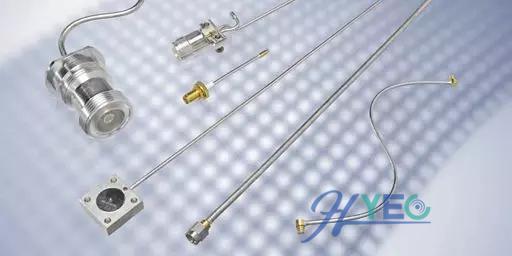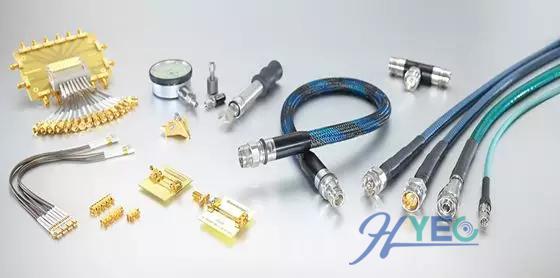In today's myriad RF applications, semi-rigid cables are still an important microwave device that is widely used. The most basic form of a semi-rigid cable is a coaxial transmission line composed of a metal tube. Wherein, the metal pipe is generally a copper pipe forming an outer conductor, and a wire conductor is arranged along a center line of the copper pipe. Therefore, the central wire conductor is supported by the dielectric material so as to be held on the same central axis of the outer conductor. Due to their wideband characteristics, reliable electrical performance and phase stability, semi-rigid components are still a popular choice for engineers.In today's myriad RF applications, semi-rigid cables are still an important microwave device that is widely used. The most basic form of a semi-rigid cable is a coaxial transmission line composed of a metal tube. Wherein, the metal pipe is generally a copper pipe forming an outer conductor, and a wire conductor is arranged along a center line of the copper pipe. Therefore, the central wire conductor is supported by the dielectric material so as to be held on the same central axis of the outer conductor. Due to their wideband characteristics, reliable electrical performance and phase stability, semi-rigid components are still a popular choice for engineers.

Main characteristics of semi-rigid cable
Wide bandwidth application
Typically, semi-rigid cable assemblies support RF signal transmission up to 65 GHz, but cable assemblies terminated with 1.0 mm connectors enable high frequency applications up to 110 GHz. Semi-rigid coaxial cables vary in size and range in diameter from 0.020 inches to 0.250 inches. Among Rosenberg's products, 0.141-inch, 0.085-inch, and 0.047-inch cables are popular. The 0.047-inch diameter cable with smaller connectors is increasingly popular with users because it supports higher frequencies. The 0.141" diameter semi-rigid coaxial cable uses high frequency SMA or 2.92mm connectors and can typically be used up to 27GHz. The 0.086-inch diameter semi-rigid coaxial cable, although often used in conjunction with HYEC.com/en/SMA-Connector.html target='_blank'>SMA connectors, operates at frequencies up to 65 GHz when terminated by a 1.85 mm connector.
Formable and retaining shape
A semi-rigid coaxial cable is a cable that has both rigidity sufficient to maintain its shape and sufficient for manual bending. For semi-rigid cables, in order to fit exactly into the system being designed, they often need to be precisely shaped into various shapes. Modeling a semi-rigid cable into the desired shape is a risky task. In order to prevent damage to the outer wall, special tools should be used to bend or shape the cable. In addition, once such a cable is shaped into a specific shape, it is extremely difficult to change its shape again. This is because shape changes often result in damage to the outer conductor, resulting in fine lines in the outer wall that ultimately affect the electrical performance of the cable assembly. Therefore, although such coaxial cables made of aluminum and soft copper are easily shaped and bent by hand, in order to minimize the risk of cable damage, it is still recommended to use special tools for such operations.
Phase stability
Since the semi-rigid coaxial cable is made of high quality material, it has extremely high electrical stability compared to a flexible coaxial cable using a wire braided outer conductor. The properties of metals and dielectric materials vary with temperature, making the use of phase-conserving cables extremely important for many critical systems. In addition, phase-matched semi-rigid cables are often used in systems where phase length control is required. This is especially true for antenna systems that are equipped with phased array antennas, test applications such as optical communications and semiconductors.
Low intermodulation (PIM)
Semi-rigid cables are usually made of a metallic material (mainly copper). When equipped with suitable connectors, these copper tube semi-rigid coaxial cables have excellent passive intermodulation performance, making them ideal for modern multi-frequency wireless communication systems including distributed antenna system related equipment. . As people's demand for full coverage increases, the distributed antenna system market requires the use of a wider variety of low-passivity intermodulation products, including filters, splitters, amplifiers, and even high-end test equipment. Semi-rigid cable assemblies are the preferred choice for these applications because they meet the RF power and passive intermodulation requirements of modern wireless communication systems.

In the field of “testing and measurement”, HYEC provides a comprehensive range of products. Includes measurement calibration, test cables, precision adapters, interchangeable port connector systems, and test components. Precision connectors include connectors, adapters for a range of ports such as RPC-N, RPC-TNC, RPC-7, RPC-SP, RPC-3.50, RPC-2.92, RPC-2.40, RPC-1.85, and RPC-1.00 And calibration components; test components include openers, shorts, loads, sliding loads, attenuators, and air lines.
Contact: Mr. Wong(Tech)
Phone: +86-15021372007
Tel: 021-66030982
Email: shhuiyong@163.com
Add: Building A, 260 Yuantai Rd, Baoshan District, Shanghai